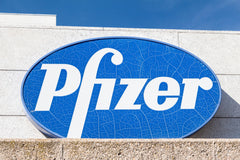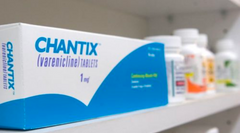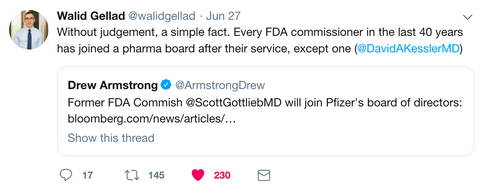The revolving door between government and big business has unfurled the welcome mat yet again, this time for ex-FDA commissioner Scott Gottlieb.

Gottlieb was widely criticized by vapers for his progressively more combative stance against vaping. In a September 12, 2018 statement, Gottlieb dubbed youth use of electronic cigarettes an "epidemic" and began referring to an "alarming surge" backed up by "staggering data."
"I now have good reason to believe that it’s reached nothing short of an epidemic," Gottlieb said in the statement. "I use the word epidemic with great care... I’ll be clear. The FDA won’t tolerate a whole generation of young people becoming addicted to nicotine as a tradeoff for enabling adults to have unfettered access to these same products."

Gottlieb began pushing for more and more draconian measures to curb this epidemic, ranging from halting the sale of e-cigs at convenience stores and gas stations to eliminating all e-juice flavors except tobacco and menthol.
“We are acting on very clear science that there’s an epidemic on the way,” Gottlieb stated. “We’re in possession of data that shows a disturbingly sharp rise in the number of teens using e-cigarettes in just the last year.”
However, actually digging into that "very clear science" in some cases tended to show that the FDA was manipulating the data to try to give the impression that the situation is worse than it is.
Gottlieb's Manipulation of the Data
Take, for example, a tweet Gottlieb posted to his FDA Twitter feed on March 8th, 2019.

The headline says, "Surge in Youth Current E-Cigarette Use," with 48% highlighted just below in red. At a quick glance, 48% sounds like a huge increase and words like “epidemic” and “surge” would seem appropriate for such a drastic jump. However, if you look more closely, the actual change was from 3.3% to 4.9% of middle school students. An increase from 3.3 to 4.9% is, technically, a 48% increase but it’s actually only a 1.6% change. While that’s not nothing, it doesn’t quite bring to mind tsunami related adjectives. Let's go in for a closer look.
We tracked down the survey that the FDA's graphic was based on, the 2018 National Youth Tobacco Survey, and it contained some interesting information.
“Among middle school students, current e-cigarette use increased from 0.6% in 2011 (60,000 students) to 4.9% (570,000 students) in 2018,” the survey stated.
In other words, since 2011 (when few people in the United States even knew what an electronic cigarette was) up until today, the number of middle school students who were vaping rose to about 5%. During this same period there was also a huge proliferation of electronic cigarettes as they went from virtually unheard of to “vape” being nominated as "Word of the Year" by Oxford Dictionary in 2014 so it's not surprising that there was an increase. But what do these numbers really mean? Are 5% of middle school students really addicted to nicotine?

What is troubling about the way Gottlieb presented this statistic is what he left out. The survey decided to define an e-cig "user" as any kid who gave "a response greater than '0 days' to the question, 'During the past 30 days, on how many days did you use e-cigarettes?'” Phrasing the question that way defines kids who took a single puff one time as "current users."
There's a big difference between youth experimentation and actual nicotine addiction and Gottlieb's statements specifically stated that it was the addiction that was the problem. Are these kids just trying out these new e-cig gizmos once or are they really getting addicted? The answer can be found buried in the footnotes.
“The proportion of current e-cigarette users who reported use on ≥20 days of the past 30 days did not significantly change.”
In other words, the number of kids who were actually vaping on a regular basis, who were actually likely to be addicted to nicotine, an addiction that requires use multiple times a day--who were what you or I might define as a "user"--did not significantly change. Given that fact, using this graphic to promote the idea that there is a "surge" in youth use linked to an epidemic of addiction comes across as disingenuous.
Here are the actual facts behind Gottlieb's graphic:
Gottlieb's presentation of this statistic along with his comment that youth vaping is "one of the most troubling public health issues today" loses quite a bit of its oomph when you actually scrutinize the data behind his graphic. While nobody wants kids getting addicted to nicotine, there are many adults who also want sane, fact based public policy that doesn't sacrifice their own right to chose, especially without a firm, un-manipulated basis in fact.
Gottlieb's Parting Sucker Punch to Vaping

Gottlieb also took a bizarre shot at the vaping industry on his way out the door by issuing a press release during the final week of his tenure at the FDA stating that the FDA was investigating a possible link between vaping and seizures. The press release was picked up by news outlets across the country, with headlines like, "Does Vaping Cause Seizures?" and "FDA Investigating Link Between Vaping and Seizures" splashed across the web.
Anyone who actually dug into the data, of course, could find out that the supposed link was based on a mere 35 reports over a period of 10 years during which time there were millions of vapers in the United States.
A smidgen of fact checking could have easily revealed that of these 35 reports, some of them also involved methamphetamines, a far more likely culprit when it comes to causing seizures. Other reports came from persons who already had a prior history of seizures suggesting the seizure in question could have had nothing to do with vaping.
A little further digging could have shown any competent reporter that putting out a press release before investigating is so far from standard practice at the FDA that it is extremely questionable. But few news entities bothered to do that digging. Instead, they just parroted the FDA press release, leaving the clear impression in the minds of the public that vaping was causing seizures.

That seems to have been Gottlieb's intention, to use his FDA pulpit to smear vaping on his final days in office by issuing a press release on the flimsiest of data knowing the mockingbird media would report it uncritically.
Gottlieb Signs On to Pfizer Board
Last week we learned that Gottlieb has signed on to the board of directors for the pharmaceutical giant Pfizer.
Gottlieb told Bloomberg News that he signed up because Pfizer is “uniquely positioned to continue having a big role in advancing global public health, and I’m honored to be a part of helping shape that future.”

The Bloomberg article blithely mentions how Gottlieb "championed efforts to curb e-cigarette use during his time at the agency." Bloomberg, however, neglects to point out that Pfizer is the maker of Chantix, a pricey drug Pfizer markets to help people quit smoking.
And we do mean pricey. GoodRx, a website that tracks prescription drug prices, reports that the average retail cost of Chantix is $514.56 (if you shop at Costco using a GoodRx coupon, you can get the price down to $425.50). That's for a month's supply. Ouch.

Vaping is a direct threat to Pfizer's bottom line. The fact that Gottlieb did so much to stymie the vaping industry only to be immediately rewarded with a lucrative seat on Pfizer's board really should be provoking public outcry.
Unfortunately, it seems the public has all but been struck mute by the noxious blowback from the speed at which the revolving door has been spinning of late. In fact, this kind of thing has become so rampant, it's just business as usual.

As Walid Gellad, Associate Professor of Medicine at Pitt Division of General Internal Medicine as well as director for the Center for Pharmaceutical Policy & Prescribing, points out, every single former director of the FDA in the last 38 years has joined a pharmaceutical board after leaving their position with only one exception (David A. Kessler, M.D.).
Gellad tweeted out the following chart:

Gottlieb's predecessor, Robert Califf, left the FDA in 2017 only to sign on with Cytokinetics in 2018. Margaret Hamburg vacated the FDA in 2015 but popped up on the board of Anylam Pharmaceuticals in 2018. And on it goes.
Members of Pfizer's board were paid $142,500 in 2018, plus approximately another $159,000 worth in stock options if cashed out today. That's pretty good graft, if you can get it.
Try our premium organic vape juice today!
We've managed to survive the vape mail ban against all odds!